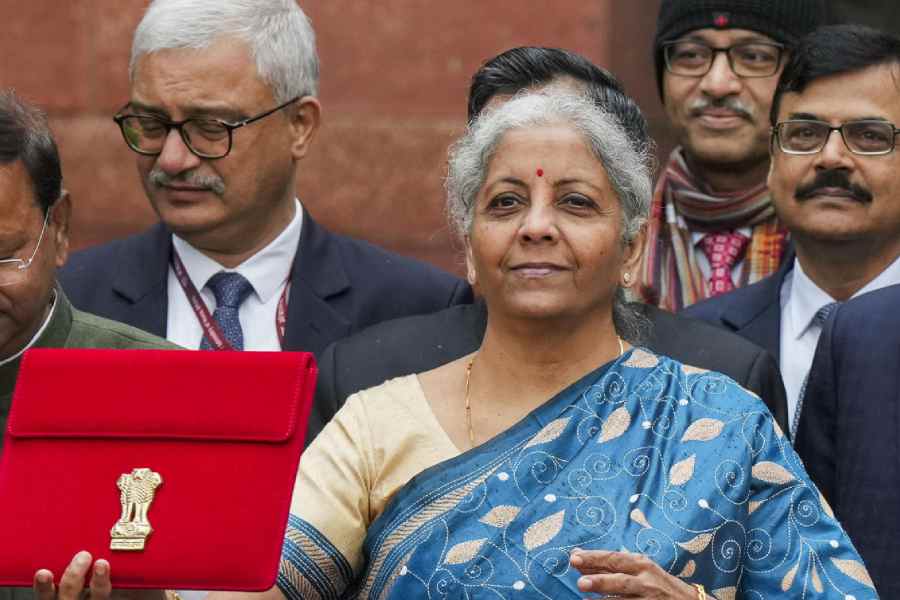Beneficiaries of the Narendra Modi government’s ambitious welfare scheme to support the construction of houses in rural areas are in for a big bump in payout in the next phase of the roll-out.
The interim budget document shows each unit would now get the support of Rs 2 lakh under the Pradhan Mantri Awas Yojna (PMAY) — Grameen compared with Rs 1.2 lakh it used to receive, translating into a 66 per cent rise in per unit allocation.
On Thursday, Union finance minister Nirmala Sitharaman said another 2 crore pucca households would be constructed over the next five years starting from 2024-25. Launched in 2016, the scheme has supported the construction of 2.54 crore homes across the country till the end of this fiscal.
The overall target under the ‘housing for all’ scheme is to build 2.95 crore pucca houses with basic amenities by 2023-24. The government has so far sanctioned funds for 2.94 crore houses.
The new scheme is likely to entail an allocation of Rs 4.18 lakh crore over the period it would run. While the Modi government is going to pick up two-thirds (63 per cent) of the tab, or Rs 2.63 lakh crore, states and Union territories are being asked to chip in with one-third of the scheme cost, which comes to Rs 1.54 lakh crore.
For the fiscal year 2024-25, Sitharaman has pledged Rs 54,500.14 crore for the PMAY-G scheme, even as it is likely to spend much less in this fiscal than what the budget had accounted for at the beginning of the year.
The spending under the scheme is likely to come at Rs 32,000 crore in 2023-24 according to the revised estimate (RE), compared with the budget estimate (BE) of Rs 54,487 crore announced in the 2023 budget.
The RE for this fiscal is also going to be lower than the actual spent in the last fiscal. The interim budget document shows that the Centre had spent Rs 44,962.21 crore in 2022-23 under the PMAY-G scheme.
States’ share
The successful implementation of the scheme would equally depend on states, many of whom are not in a fiscally good place.
In some Opposition-ruled states, a war of words has broken out on who should claim the credit for the scheme which is funded by the Centre, largely, and states.
For instance, the Centre has stopped releasing its
share of funds to applicants in Bengal citing violations in scheme conditions laid down by it.
The political slugfest between the Modi government at the Centre and the Mamata Banerjee government in Bengal over the release of centrally sponsored welfare scheme funds has reached a crescendo ahead of the general election later this year.
On Saturday, CM Banerjee announced that the state government would clear unpaid dues of 21 lakh workers under the MNREGA scheme.
It is estimated paying the central share of the MNREGA could cost the Bengal exchequer Rs 7,000 crore.
Banerjee also assured to look into the issue of withholding disbursal of central funds for the Awas Yojna. If she promises to clear the dues for PMAY-G, also, an additional fiscal burden will hit the already beleaguered state finance.
In a written reply to Parliament in December 2023, Union rural development minister Sadhvi Niranjan disclosed that 11,06,832 houses were sanctioned in Bengal in 2022-23,
the highest in the last five fiscal years starting from 2018-19.
In the interim budget, the Centre appears to emphasise that the success of the scheme, ongoing and in the future, is in part dependent on the genuineness of the beneficiary.
“The programme is the first of its kind wherein the genuine beneficiaries are identified based on housing deprivation parameters as per SECC-2011, followed by verification process at the Gram Sabha level and geo-tagging of the beneficiaries to confirm the genuineness,” an explainer of the PMAY-G, read.










